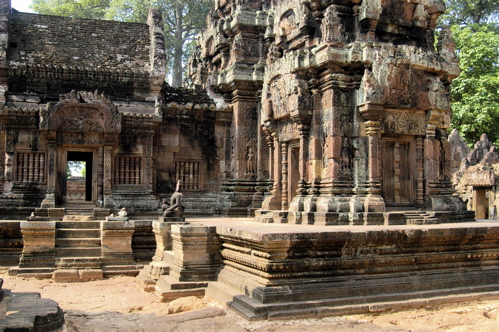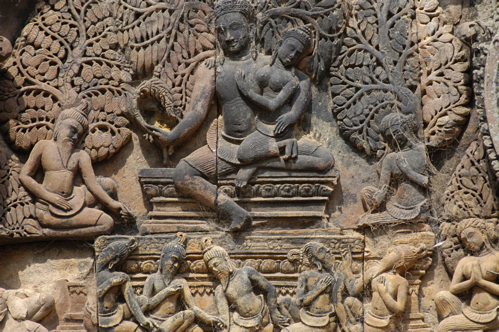Banteay Srei Temple Angkor
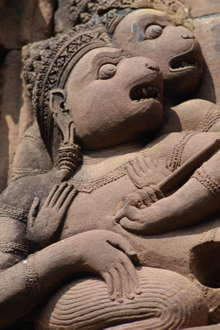
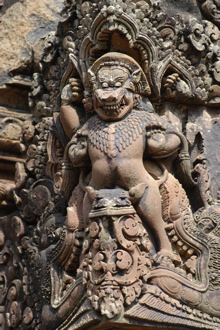
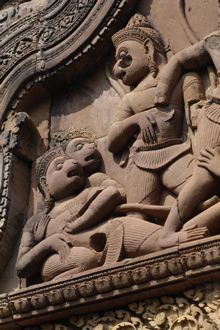
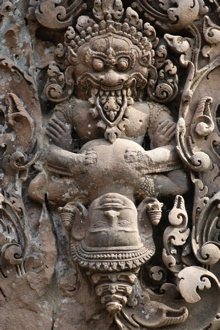
- Banteay Srei is a Khmer temple dedicated to the ancient Hindu God Shiva which was constructed in the 10th century and consecrated about 962. Following the destruction of Angkor by the Siamese armies this Temple was left to be covered in forest until it was rediscovered in 1914. We now know the history of the monuments from the original stone stela which was discovered in 1936.
- It is located 25 kilometers north east of Angkor Thom. It is the fourth most interesting set of monuments after Angkor Wat, Angkor Thom and the Bayon and Preah Khan. The trip by road vehicle also offers a good view of Cambodian countryside.
- The name ''Banteay Srei in Khmer means '' Citadel of Women ''. Originally it was called a Shiva Temple ''Great Lord of the Threefold World''. The name, Citadel of Women, today has no significance save it may refer to the numerous bas relief carvings of Devatas throughout the monuments.
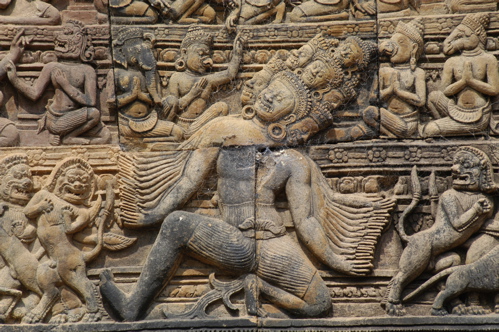
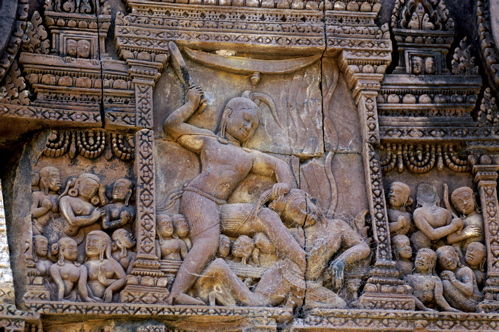
The Architecture of Banteay Srei.
- Banteay Srei is orientated towards the East. It is designed with three concentric rectangular enclosures situated on an east to west axis.
- The structures include, the Outer Gopura, the Outer Enclosure, the Inner Enclosure, the Two Libraries and the Sanctuary within the Inner Enclosure.
-
The Outer Gopura is the only remains from the original wall which is estimated to have been 500 meters square approximately. When one enters from here one follows a 70 meter causeway to the Outer Enclosure [ referred to as the third enclosure ]. On either side of the causeway are small galleries. On these structures are pediments of note. On the eastern, [ outside ] side of the Gopura pediment is the depiction of the Hindu ''God'' Indra mounted on ''Airavata'', the three headed Elephant. In Thailand Airavata is called ''Erawan ''.
- The Outer Enclosure is approximately 110 meters by 95 meters and is contained behind a laterite wall with its Gopuras at its western and eastern sides. One enters through the east side and leaves through the west. Inside the Outer enclosure is a moat as shown in the picture above. The pediment for the eastern Gopura is on the ground near the front entrance and depicts the Hindu mythology scene of a demon taking Rama's wife, Sita, as depicted in the Ramayana. The pediment from the western Gopura is in the Musee Guimet in Paris France and it depicts the Asunra brothers, Sunda and Upasundra fighting over the Apsara, Tilottama as again depicted in Hindu mythology.
- The Second Enclosure is between its outer laterite wall as shown in the picture above and the inner brick wall. Here the Gopuras feature bas reliefs and pediments.
- The Inner Enclosure [ the First Enclosure ] contains the two libraries and the Sanctuary.


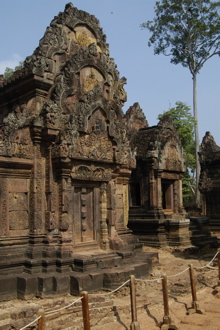

The Deity [ God ] Shiva In the Hindu Religion
- Shiva is the destroyer of the world. He is the
greatest god in Saivaism.
- In the Shivapurana scripture, it is stated
that he is the origin of the universe including all three principal
gods.
- Shiva in his human form has three eyes, one in the middle of the
forehead, with matted hair decorated with crescent moon. He wears
tiger, elephant, or dear skin and has snakes as an ornament. His
different weapon is called Trisula but people mostly worship the lingas
which are made in different sizes. Actually, there are two kinds of
lingas which are; movable, made of soil, metal or precious stone, and
unmovable which can be divided into several kinds.
- His abode locates on
Mount of Kailasa [ as depicted in image on this page ].
- He has a consort called Uma or Parapati and other
names, and sons called Ganesa or Vighnesvara, Kamara, Skanda or
Kartikeya.
- Nandi or Usuparaja Bull is his vehicle.
- Both his consort
and his sons, along with the vehicle is highly respected among his
Saiva followers.
- Shiva has numerous amount of names according to his
forms and might, as well as the legends according to his origins.
- In Thailand, he is well-known as Isavara in the ancient scripture, he is called Rudra (the destroyer) and later he has got the name Shiva which means the cleaner. This relates to his duty as the destroyer in that to destroy is to eradicate the impurity. After the destruction, he builds a new world of purity. This is the reason why he is called Isvara, Mahesa or the Mahadeva, which means the greatest god of all.
- In Hinduism, there is a large number of deities [ Gods ]. The
original ones in the early period such as Indra or Varuna
are still
respected until now, but their significance is less.
- The three
principal gods of Hinduism are Brahma, Vishnu, and Shiva. Together,
they are called Trimurti [ the three forms,''Tri'' [ three], ''murti'' [ form ].
These three gods are respected unevenly. Although there have been attempts
to combine all gods together, Hindus normally worship only one god. As
a consequence, Hinduism is separated into several denominations depending upon which God they respect.
- The worship of Shiva called Saivism.
- The worship of Vishnu called Vaishnavism.
- Both Saivism and Vaishnavism also
have sub-denominations of their own.
- Although Brahma is
one of the principal gods like Shiva or Vishnu, he does not have a
particular denomination of his own.
- There is also a denomination, such as Sakti [ power or strength ], which respects the goddesses who are the consorts of the principal gods for example Uma, Shiva’s consort, Lakshmi [ depicted in the image opposite ], Vishnu’s, and Sarasvati, Brahma’s consort, believing that the wives are the husbands’ source of power and strength. Normally, Uma is the most-respected. She reincarnates into several forms which also have different names.
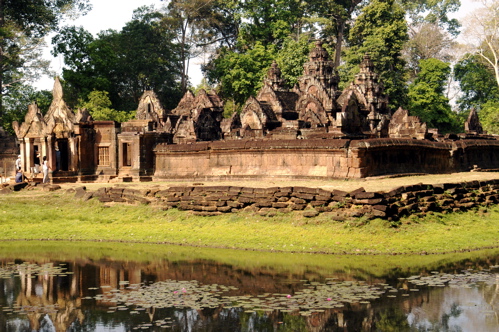
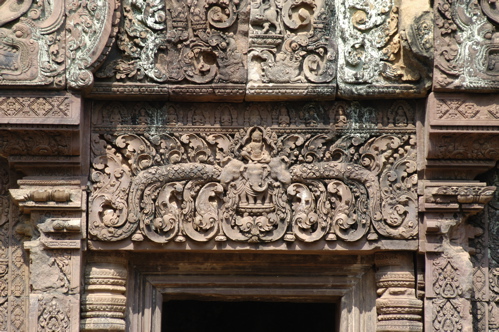
- Within the Inner Enclosure at Banteay Srei are two libraries. These are each made of bricks, red stone and laterite. Each library building has an eastern and a western pediment, each with its own artistic depictions in stone from some event in Indian Hindu mythology.
- As shown in the pictures east facing pediment on the southern library shows Shiva seated on the summit of Mount Kailasa, his mythological abode. His consort Uma sits on his lap and clings anxiously to his torso. Other beings are also present on the slopes of the mountain, arranged in a strict hierarchy of three tiers from top to bottom. In the top tier sit bearded wise men and ascetics, in the middle tier mythological figures with the heads of animals and the bodies of humans, and in the bottom tier large animals, including a number of lions. In the middle of the scene stands the ten-headed demon king Ravana. He is shaking the mountain in its very foundations as the animals flee from his presence and as the wise men and mythological beings discuss the situation or pray. According to the legend, Shiva stopped Ravana from shaking the mountain by using his toe to press down on the mountain and to trap Ravana underneath for 1000 years.
- The west-facing pediment on southern library shows Shiva again seated on the summit of Mount Kailasa. He is looking to his left at the god of love Kama, who is aiming an arrow at him. Uma sits to Shiva's right; he is handing her a chain of beads. The slopes of the mountain are crowded with other beings, again arranged in a strict hierarchy from top to bottom.
- Just under Shiva sit a group of bearded wise men and ascetics, under whom the second tier is occupied by the mythological beings with the heads of animals and the bodies of humans; the lowest tier belongs the common people, who mingle sociably with tame deer and a large gentle bull.
- According to the legend, Kama fired an arrow at Shiva in order to cause Shiva to take an interest in Uma. Shiva, however, was greatly angered by this provocation, and punished Kama by gazing upon him with his third eye, frying Kama to cinders.
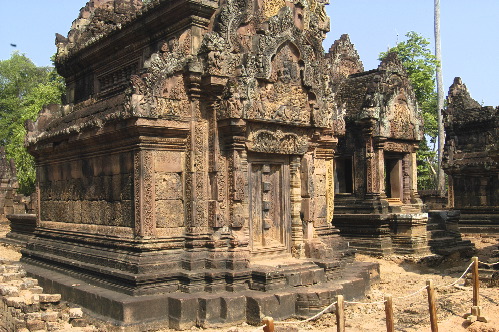
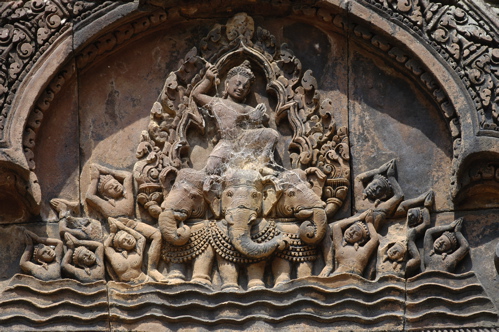
- The east facing pediment on the northern library shows the god of the sky Indra creating rain to put out a forest fire started by the god of fire Agni for purposes of killing the nāga king Takshaka who lived in Khandava Forest. The Mahabharatan heroes Krishna and Arjuna are shown helping Agni by firing a dense hail of arrows to block Indra's rain. Takshaka's son Aswasena is depicted attempting to escape from the conflagration, while other animals stampede about in panic.
- The west-facing pediment on the southern library depicts Krishna slaying his wicked uncle Kamsa.
